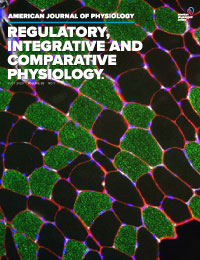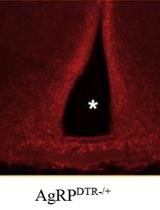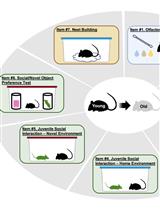- EN - English
- CN - 中文
Development of the Deoxycorticosterone Acetate (DOCA)-salt Hypertensive Rat Model
醋酸脱氧皮质酮盐型高血压大鼠模型的建立
发布: 2020年08月05日第10卷第15期 DOI: 10.21769/BioProtoc.3708 浏览次数: 6558
评审: sonal arvind patelAlessandro DidonnaAnonymous reviewer(s)

相关实验方案
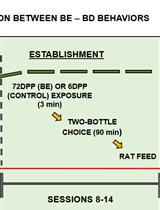
从食物到酒精的狂饮:雄性Wistar大鼠嗜酒行为之间的顺序相互作用
Sergio Cuesta-Martínez [...] Cruz Miguel Cendán
2023年08月05日 1325 阅读
Abstract
According to the World Health Organization (WHO), nearly 1.13 billion people worldwide have hypertension, a major factor responsible for premature death globally. The inherent multifactorial nature of hypertension makes its study difficult since the chronic rise in blood pressure depends on the intricate connection between dietary, genetic and environmental factors. Therefore, the pathophysi-ology of hypertension is not completely understood. For these reasons, there is an ongoing search for animal models that better mimic changes resulting from this disease. Because of its complexity, the use of animal models aimed at elucidating the pathogenesis of hypertension and to evaluate new therapeutic possibilities is an important tool for understanding this disease since it enables consistent experimental strategies that are impractical in humans. Over time, many animal models have been developed for the study of chronic increases in blood pressure ranging from genetic models that include the spontaneously hypertensive rat (SHR) and genetic manipulations, such as the TGR (mRen2) rat, as well as neurogenic or endocrine models. One of the most commonly used hypertensive rat models today is that of hypertension induced by treatment with deoxycorticosterone acetate associated with high sodium intake, i.e., the DOCA-salt model. This model is known to have a neurogenic component linked to increased sympathetic nervous system activity, and as such the DOCA-salt model promotes cross-talk between endocrine and neural components that lead to increased blood pressure, and may impact the functioning of other organs.
Background
Hypertension is a chronic disease with the highest incidence in the world in that more than 1.13 billion people are hypertensive (Lerman et al., 2019; https://www.who.int/news-room/fact sheets/detail/hypertension). Although the understanding of the pathophysiology of hypertension has advanced considerably in recent years, it is still very difficult to elucidate the causes, as well as to define effective strategies in the treatment of this disease (Hall et al., 2012; Collister et al., 2018). This difficulty is not surprising due to the fact that hypertension is a multifaceted disease resulting from a variety of risk factors (diet, genetics and environment), as well as interactions between them. Adding to this complex nature is the fact that the maintenance of both short and long-term blood pressure is under control of a wide variety of systems such as cardiovascular, neural, endocrine, renal as well as local vascular tissue mediators (Hall et al., 2012; Basting and Lazartigues, 2017). As in many other human diseases, animal models of hypertension have been a valuable tool in understanding its pathogenesis, enabling experimentais approaches that would be difficult to reproduce in humans (Lerman et al., 2019). However due to the multifactorial aspects of hypertension, not all available animal models are effective in mimicking the real condition imposed by this disease. One of the most commonly used animal models is mineralocorticoid-induced hypertension in the rat: deoxycorticosteroid acetate (DOCA) which has two variations: 1) DOCA plus added salt (DOCA-salt), which incorporates a high-salt diet (0.6-1% NaCl in the drinking water) and 2) DOCA-salt that is accompanied by uninephrectomy (Zicha et al., 1989; Grobe et al., 2011). One of the main advantages of this model is that in both variations, salt sensitivity, a key element for predisposition and development of many cases of hypertension, is present to a similar extent to what occurs in human salt sensitive hypertension (Basting and Lazartigues, 2017).
Previous work in animals non-uninephrectomized animals demonstrated that the development of hypertension occurs more gradually with 28 days of treatment with DOCA resulting in a blood pressure increase of 20 to 30 mmHg (Kandlikar and Fink, 2011). Uninephrectomized animals showed the same pattern of increased blood pressure, but in a shorter period of time after 21 days of treatment with DOCA (Collister et al., 2018). In both cases, animals treated with DOCA demonstrated a typical hypertensive response in the first 7 days of treatment. But non-uninephrectomized animals showed the magnitude of the increase in blood pressure more modest than uninephrectomized rats. We have utilized 21 days of DOCA treatment in uninephrectomized rats because we observe differences between interventional experimental animals and control animals during this shorter time frame. In this DOCA-salt model accompanied by reduced kidney mass (uninephrectomy), chronic hypertension develops in a biphasic response with an initial rise in BP over first 7 days followed by a sustained elevated BP over days 14-21 that eventually reaches 125-135 mmHg (Collister et al., 2018).
Since this model is thought to have a neurogenic component mediating the rise in arterial pressure, we sought to determine which area(s) of the brain may be involved in the chronic hypertensive response to DOCA. Therefore, we have previously used this model to investigate the role of the subfornical organ (SFO) and organum vasculosum of the lamina terminalis (OVLT) in the control of arterial blood pressure. Both of these central nuclei are defined as circumventricular organs, hypothalamic structures lacking the blood brain barrier, allowing blood born chemicals such as hormones to gain access to the brain. Previous studies were performed separately in which rats were subjected to electrolytic lesion of either the SFO or OVLT, or respective sham control operation. In the first study, we reported that SFO does not play a significant role in the development of DOCA-salt hypertension as rats with lesions of the SFO responded with a similar chronic hypertensive response to DOCA compared to rats with sham lesions of the SFO. In contrast, lesion of the OLVT significantly attenuated the chronic hypertensive response in rats that consumed a high-salt diet treated with DOCA. Therefore, we concluded the hypertensive response in DOCA-treat rats requires an intact OVLT but not SFO (Osborn et al., 2006; Collister et al., 2018).
In summary, while every animal model has its limitations in comparison to human disease, the DOCA-salt hypertensive model in rats is a reliable animals model that closely mimics many human forms of hypertension in that there are volume-dependent, vascular, and neurogenic components that impact both central and peripheral nervous systems (Basting and Lazartigues, 2017, Collister et al., 2018; Lerman et al., 2019).
Finally, in addition to animal models that mimic the physiological changes typical of hypertension, accurate monitoring and recording of blood pressure fluctuations in animal research has helped researchers to unravel several mechanisms involved in the physiology and pathophysiology of diseases such as hypertension and heart failure (Huetteman and Bogie, 2009). Blood pressure and heart rate can be measured directly from the implantation of radio telemetry devices which are considered the ‘gold standard’ for the measurement of these parameters in intact, conscious laboratory animals during normal behavioral and physiological states (Zhao et al., 2011). These data are collected and recorded without direct human–animal contact during the measurements. Figure 1 shows the basic components of telemetry system used in this protocol.
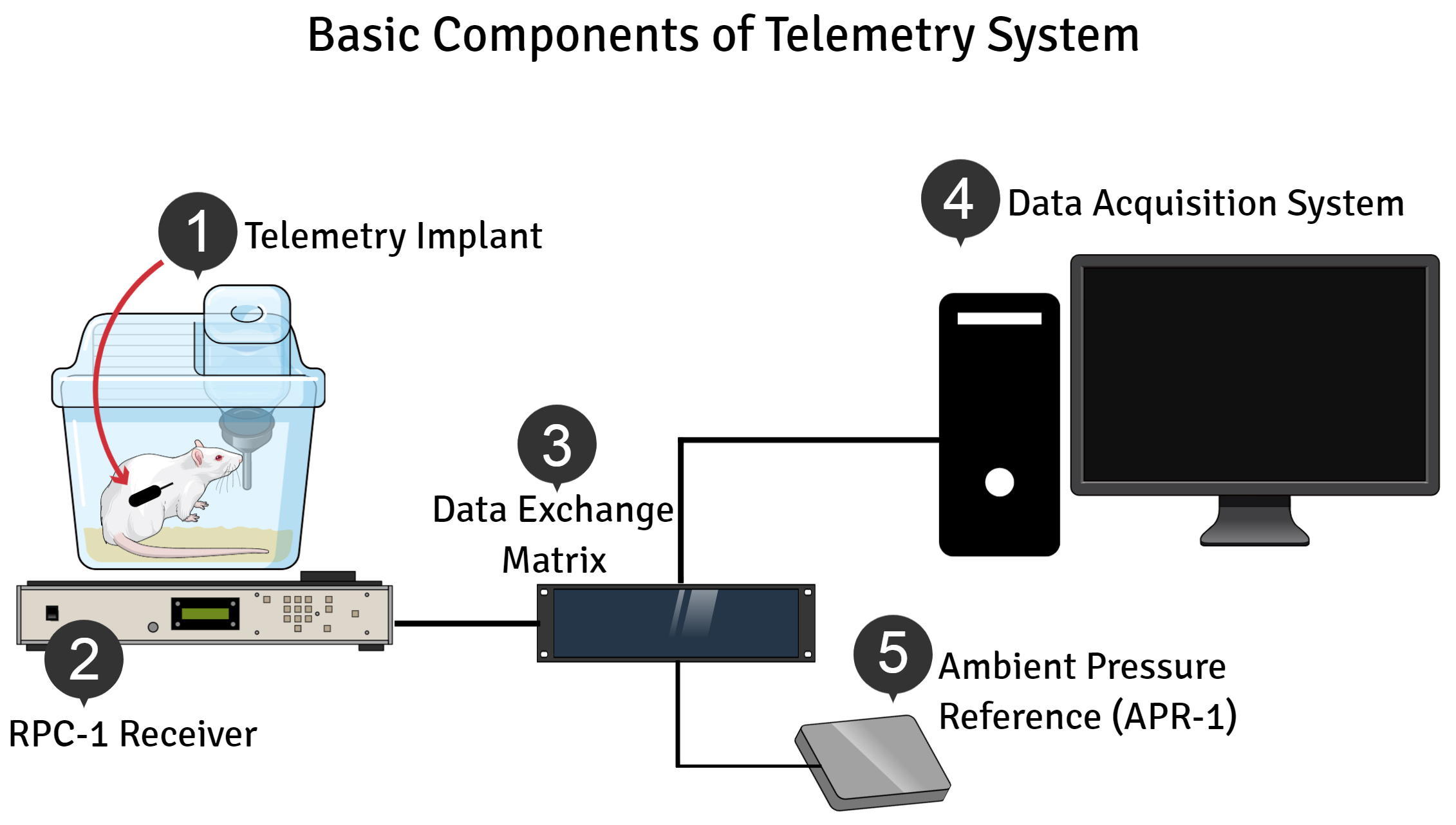
Figure 1. Basic Components of Telemetry System (for more information we recommend to consult Reference 5). 1) Telemetry implant is a device inserted in the rat’s abdominal cavity and subsequently senses, measures and transmits the information of mean pressure and heart rate to a nearby receiver via radio telemetry. 2) The RPC-1 receiver detects the transmitted signals from the implant and converts them into a readable form by the computer, and is positioned under or near the animal's cage. 3) Data Exchange Matrix immediately detects the type and serial number of the RPC-1 receiver and forwards this information to the acquisition system. 4) The Data Acquisition System (hardware, software, and computer) removes most corrupt values obtained telemetrically and converts them to common units. In addition, it provides built in routines to plot and analyze acquired data. 5) The Ambient Pressure Reference (APR 1) is needed to measure barometric pressure. Thus, the pressure values detected by the APR-1 are used to correct the pressure measurements obtained from the implant for changes in barometric pressure.
Materials and Reagents
- Needles (Standard Hypodermic Needles, MonojectTM , catalog numbers: 8881250255 [23G] , 8881250149 [21G] ), stored at room temperature
- Sterile drape, 18” x 26” (McKesson Minor Procedure Drape, catalog number: 25-517 ), stored at room temperature
- Tape (TimeMed Labeling System, catalog number: 3114 ), stored at room temperature
- Syringe (1 ml Tuberculin Syringe Regular Tip) (MonojectTM , catalog number: 8881501400 , stored at room temperature
- Syringe (3 ml Luer Lock Syringes) (MonojectTM , catalog number: 8881513934 ), stored at room temperature
- Sterile Gloves (Synthetical Surgical Gloves Powder-Free, Confiderm® SPT), stored at room temperature
- Gauze sponges (Non-woven Gauze Sponges, 2 in. x 2 in. [5.08 cm x 5.08 cm]) (AVANT GAUZE® , catalog number: 25223 ), stored at room temperature
- Cotton tip applicators (Non-Sterile Cotton Tipped Applicators, length: 6”) (SolonCare® , catalog number: 71704 ), stored at room temperature
- Polystyrene Weighing Dish (Weigh Dish PS, 1 5/8” x 1 5/8” x 5/16” [Small]) (Fisherbrand® , catalog number: 02-204A ), stored at room temperature
- Aluminum foil (Clark Foodservice, catalog number: CF 1851 ), stored at room temperature
- Surgical 3-0 Silk (Black Braided Silk, 3-0 USP) (Surgical Specialities, catalog number: SP117 ), stored at room temperature
- Surgical staples (Reflex Skin Closure System, Clip Applyer, 7 mm) (Agnthos, catalog number: 204-100 )
- Adult male Sprague-Dawley rats (250-275 g; approximately 50 days old, Charles River Laboratory, Wilmington, MA)
- Deoxycorticosterone acetate, DOCA (Sigma-Aldrich, catalog number: D7000-5G , CAS: 56-47-3), stored at room temperature
- Bag of saline solution (Sodium Chloride 0.9% Bags for Injection [1,000 ml]) (Baxter, catalog number: 0338-9543-06 ), stored at room temperature
- 70% Isopropyl Alcohol (473 ml) (Medline Industries, catalog number: 53329-800-06 ), stored at room temperature
- Iodine antiseptic solution (Povidone Iodine Scrub, 960 ml) (Prority Care, catalog number: 50009-110-32 ), stored at room temperature
- Disinfectant soap (Chlorhexidine Gluconate 2% Solution Antiseptic (Scrub-StatTM ECOLAB® , catalog number: 47593-463-31 ), stored at room temperature
- Heparin 50 units/ml (Heparin Sodium Injection USP, 50 units USP per ml) (B. Braun Medical Inc., catalog number: 0264-9577-10 ), stored at room temperature
- Isoflurane (Rx only, Liquid for inhalation, 250 ml) (Piramidal Enterprises Limited, catalog number 6679401725 ), stored at room temperature.
- Ketoprofen (Ketofen, 100 mg/ml) (Zoetis Inc., catalog number: 140269 ), stored at room temperature
- Gentamicin sulfate, 200-395 [100 mg/ml] (ANADA, catalog number: 1398563304 ), stored at room temperature
- Atropine (Sulfate injection, USP [8 mg/20 ml], catalog number: 0 641600601 ), stored at room temperature
- Pentobarbitol (Fatal-Plus solution CII [390 mg/kg, 250 ml, RXV CII [2N]), stored at room temperature
- Buprenorphine hydrochloride (Injection CIII [0.3 mg/ml]) (Buprenex® , catalog number: 12496-0757-5 ), stored at 20 °C to 25 °C
- Lubricant Eye Ointment (Major Pharmaceuticals [3.5 g]) (LubriFreshTM P.M., catalog number: 0904-5168-38 ), stored at room temperature
- Sylgard 184 Silicone Elastomer (Two-part silicone elastomer supplied as flowable liquid, Sylgard 184® [500 g]) (Dow Corning, catalog number: 2404019862 ), service range of -45 °C to 200 °C
- Standard Rat Chow (2018 18% Protein Rodent Diet, Teklad Global Diets® ) (Envigo, catalog number: 44220 ), stored at room temperature
- 0.1% NaCl powdered food (Mature Rodent Diet with 0.1% added Sodium Cloride, Open Source DietsTM , Research Diets) (New Brunswick, catalog number: D17020M ), stored at 4 °C
- Sodium Chloride, NaCl (Sodium Chloride Certified ACS Crystaline, 500 g) (Fisher Chemical, catalog number: S271-500 ), stored at room temperature
- Fiber Patch (PA-C40 cellulose patch, Data Sciences International, St. Paul, MN)
- VetBond surgical adhesive (Tissue Adhesive, 3 ml Bottles w/MSDS) (3M VetbondTM , catalog number: 1469SB ), stored at room temperature
- 0.9% NaCl drinking solution (see Recipes)
Equipment
- Instruments (Figure 2)
Micro dissecting retractor (A1 and A4)
Long hemostatic forceps (A2)
Needle holder (A3)
Curved hemostatic forceps (A5)
Micro dissecting straight little scissors (A6)
Surgical scissors (A7, A8 and A14)
Auto-clip applier for 9 mm (A9)
Scalpel with scalpel blade number 10 (A10)
Scalpel handle (A11)
Needle support (A12)
Micro aneurism clip (A13)
Forceps (A15 and A17)
Medium hemostatic forceps (A16)
Dissecting forceps with teeth (A18)
Micro dissecting Forceps (A19)
Small Spatula (B1)
Weighing Dish (B2)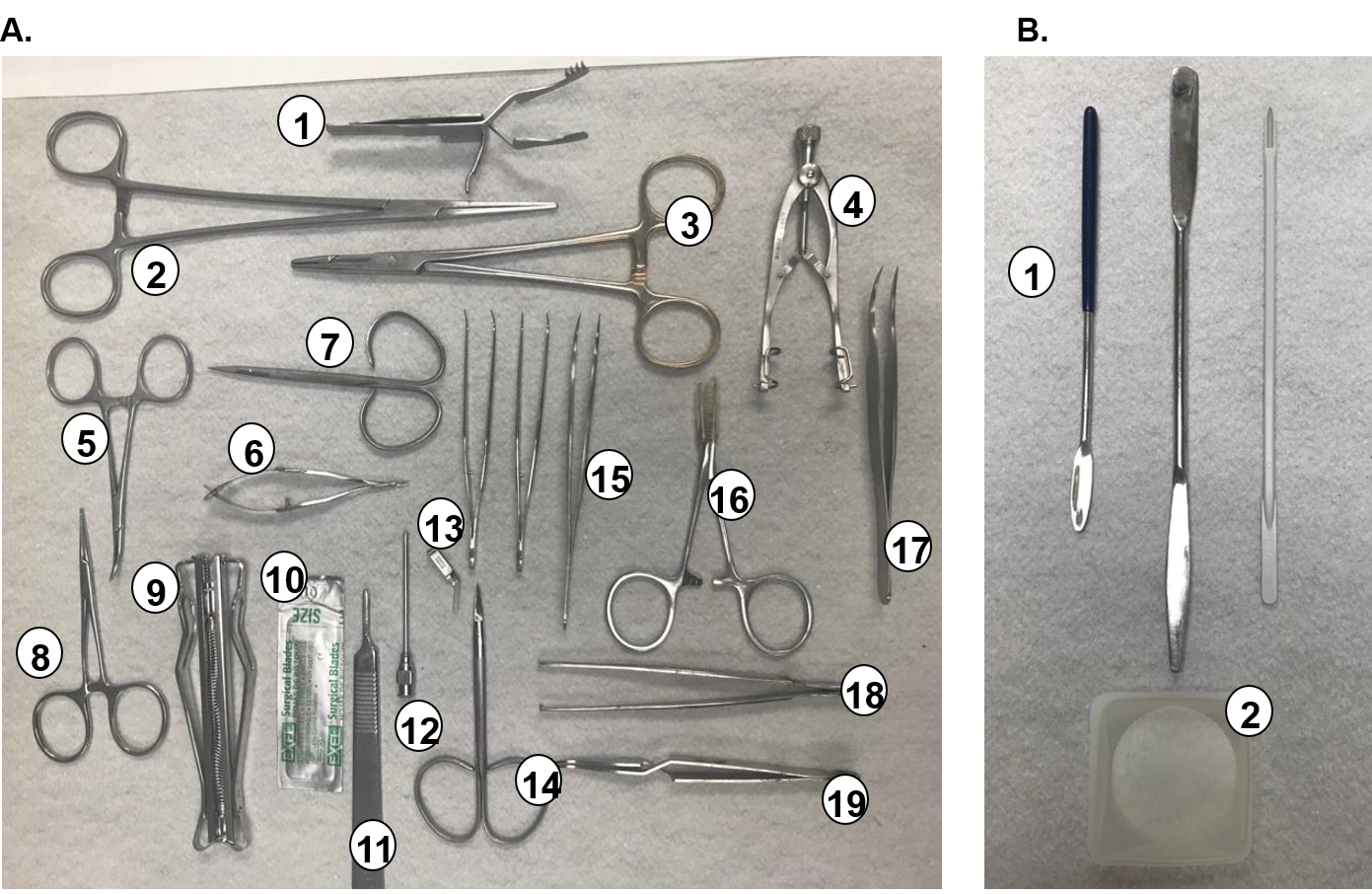
Figure 2. Instruments used in surgical procedures (A) and preparation of DOCA pellets (B) - Supplemental heating (Pad Heating, 18” x 26” [46 cm x 66 cm]) (MultPad, Stryker, catalog number: TP26E ), stored at room temperature
- Clipper for hair removal (Oster® Golden A5® , Detachable Blade, 120 Volts AC, 45 Watts; [size 40])
- Metabolic cages (Nalgene Metabolic Cage) (Ancare, catalog number: 650-0100 )
- Single Cage Stand (Ancare, Bellmore, NY. For more information: www.ancare.com)
- Vertical Metabolic Cage Rack (Ancare, Bellmore, NY. For more information: www.ancare.com)
- Isoflurane vaporizer (Vapomatic Anesthetic vaporizer, SKU: 20010, NY) (VapomaticTM , catalog number: 2200 )
- Veterinary Anesthesia Machine (Am Bickford Anesthesia Machine, catalog number: 61020 ; SKU: 61020 B, NY)
- Rat Induction chamber (Induction Chamber, 1 Liter 3.75"W x 4.50"D x 3.75"H Designed for a single mouse or small rat) (VetEquip® , catalog number: 941443 )
- Heat Therapy Pump (T/Pump® , Stryker Medical, model: TP 700 )
- PA-C40 transmitter (TA11PA-C40, Data Sciences International, catalog number: 270-0040-008 ), stored at room temperature
- AM Radio (FM/AM, DC: 3V R6 Size AA x 2 Batt or Equiv, Sony® , model: ICF: S10MK2 )
- Telemetry receiver (RPC-l, DSITM , catalog number: 272-6001 )
- Data Exchange MatrixTM (DSITM , St Paul, Minnesota, USA)
- Ambient Pressure Reference (DSITM , model: APR-1 )
- IBM computer
Software
- Dataquest IV software (DSITM, www.dataquest.io)
- Microsoft Excel
- Sigma Plot (Sigma Plot 9.0, The Technical Graphing Standard, SYSTAL, www.systal.com)
- Mind the graph (www.mindthegraph.com)
Procedure
文章信息
版权信息
© 2020 The Authors; exclusive licensee Bio-protocol LLC.
如何引用
Pestana-Oliveira, N., Nahey, D. B., Johnson, T. and Collister, J. P. (2020). Development of the Deoxycorticosterone Acetate (DOCA)-salt Hypertensive Rat Model. Bio-protocol 10(15): e3708. DOI: 10.21769/BioProtoc.3708.
分类
神经科学 > 行为神经科学 > 实验动物模型
细胞生物学 > 组织分析 > 电生理学
您对这篇实验方法有问题吗?
在此处发布您的问题,我们将邀请本文作者来回答。同时,我们会将您的问题发布到Bio-protocol Exchange,以便寻求社区成员的帮助。
Share
Bluesky
X
Copy link


